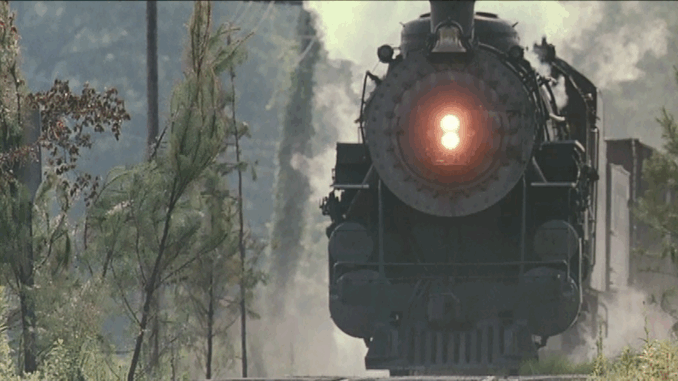
Where Strength First Sparked
One of the most unforgettable scenes in Fried Green Tomatoes is when a young Idgie Threadgoode stands defiantly on a railroad track, daring a speeding train to hit her. It is not just a thrilling moment of recklessness—it is the emotional birthplace of a powerful bond between Idgie and Ruth Jamison, the two central women whose story carries the emotional weight of the film. More than a dramatic stunt, the train scene becomes a symbol of courage, resistance to societal expectations, and the raw emergence of personal freedom.
The Context: Idgie’s Rebellion and Grief
Set during a time when Idgie is still reeling from the death of her beloved brother Buddy, the scene serves as a raw expression of pain and rebellion. Ruth, a refined young woman from the church, is invited to spend the summer with the Threadgoode family in hopes that her calm influence might help “tame” the wild, grieving Idgie. Instead, she bears witness to the beginning of Idgie’s transformation.
As Ruth watches, Idgie walks out onto the train tracks while a locomotive barrels toward her. Townspeople shout at her to move, but she stands still, arms stretched wide like a dare to the universe. At the last possible moment, she jumps clear.
It is the first time Ruth sees beneath Idgie’s angry, untamed exterior and glimpses the deep well of sorrow—and strength—that drives her.
Symbolism: The Train as Society, and Idgie’s Defiance
In many ways, the train represents society itself: heavy, fast-moving, unstoppable. It’s the symbol of tradition, progress, and conformity. Idgie standing on those tracks, refusing to move, is her way of rejecting the rules laid out for her. She will not conform to the roles of obedient daughter or quiet mourner. She will not be told how to grieve, how to love, or how to behave. It’s the first visible moment in the film where we understand that Idgie is different—not just rebellious, but revolutionary in her spirit.
Ruth’s presence in this moment is vital. She does not scold or shame Idgie. She watches—startled, perhaps, but also captivated. The seeds of their connection are planted here, on the very edge of danger and vulnerability.
Building the Bond: A Shift in Ruth

This scene also marks the beginning of Ruth’s transformation. Up to this point, Ruth is polite, gentle, and deeply embedded in the expectations placed upon her as a Southern woman. But witnessing Idgie’s raw freedom awakens something inside her. Though she won’t act on it yet, Ruth is drawn to that energy. In this pivotal moment, their friendship—eventually their great love—is born not out of calm understanding, but shared intensity.
Ruth begins to look at Idgie not as someone to fix, but someone to understand—and eventually, someone to join in resistance against the restrictions of their era.
A Defining Scene in Idgie’s Character
From a narrative standpoint, the train scene is where we truly meet the real Idgie. It’s not enough to know she’s Buddy’s little sister or that she’s grieving. It’s here that we realize she is a force unto herself. Her boldness, her refusal to back down, her instinct to test limits—all of it points to the life she will lead: unconventional, full of risk, and deeply loyal to those she loves.
We also see how she copes with grief. The danger becomes a substitute for her pain. Rather than cry or conform, she pushes herself to the edge of danger to feel something real again.
Cinematic Power: Visuals, Sound, and Impact
From a filmmaking perspective, the train scene is executed with gripping tension. The camera lingers on Idgie’s defiant posture, the crowd’s panic, and Ruth’s stunned silence. The sounds of the train roaring down the track, the wind lifting Idgie’s hair, and the abrupt silence when the danger passes—all work together to sear this moment into the viewer’s memory.
It’s one of the first times in the film when the audience fully sees Idgie’s spirit. The thrill of the scene is not just physical—it’s emotional.
Lasting Legacy: A Metaphor for Women’s Resistance
Years later, when viewers recall Fried Green Tomatoes, this scene often comes to mind not because of the train itself, but because of what it represents. In a society where women were expected to be quiet, proper, and obedient, Idgie’s fearless stance becomes a metaphor for defying the expected path.
For generations of women watching, Idgie becomes a symbol of rebellion. And Ruth’s presence, her silent recognition and eventual shift, reminds us that courage is contagious. One bold act can awaken another soul.
Conclusion: Where Everything Began
The train track scene is more than just early drama—it is the heartbeat of what is to come. It is the start of Idgie and Ruth’s story, not just in terms of plot, but in emotional resonance. From that moment forward, the audience knows they are watching something extraordinary—a friendship, a love, and a way of living that dares to defy the rules.
In Fried Green Tomatoes, this one moment says everything: stand on the tracks, even when the world tells you not to. Sometimes, the most dangerous place is the one where we finally find ourselves.
